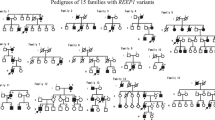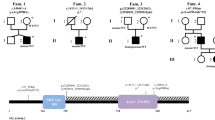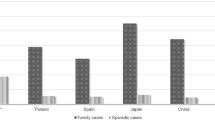Abstract
Spastic paraplegia (SPG) type 4 is an autosomal dominant SPG caused by functional variants in the SPAST gene. We examined a Japanese family with three autosomal dominant SPG patients. These patients presented with typical symptoms of SPG, such as spasticity of the lower limbs. We identified a rare nonsynonymous variant, NM_014946.4:c.1252G>A [p.Glu418Lys], in all three family members. This variant has previously been reported in a Russian SPG family as a “likely pathogenic” variant.5 Ascertainment of additional patients carrying this variant in an unrelated Japanese SPG family further supports its pathogenicity. Molecular diagnosis of SPG4 in this family with hereditary spastic paraplegia is confirmed.
Similar content being viewed by others
Hereditary spastic paraplegia (HSP) is a group of clinically and genetically heterogeneous disorders characterized by progressive lower-limb spasticity and weakness as a result of corticospinal dysfunction1,2. The most common type of HSP is spastic paraplegia 4 (SPG4, MIM: 182601), accounting for 15–40% of all HSP cases3. SPG4 is autosomal dominant and caused by functional variants in the SPAST gene, which is located at 2p22.3 and encodes the microtubule-severing protein spastin1,4.
Kadnikova et al.5 previously identified NM_014946.4:c.1252G>A [p.Glu418Lys] in a single Russian spastic paraplegia (SPG) family5. Although the authors reported the variant as “likely pathogenic” according to the guidelines of the American College of Medical Genetics (ACMG), the Association for Molecular Pathology (AMP), and the College of American Pathologists (CAP)5,6, it is necessary to assess additional patients carrying the same variant in unrelated SPG families for a final conclusion regarding the pathogenicity of the variant.
We evaluated a Japanese pedigree of SPG including three patients (proband (I-2), her daughter (II-2), and son (II-3)) (Fig. 1). The proband was a 55-year-old Japanese woman who noticed a stretched feeling of the lower limbs approximately at age 40. She needed a cane for walking. On neurological examination, she showed typical SPG, with a moderate vibration sense decrease in the lower extremities. The proband’s daughter (II-2) was a 30-year-old who had a history of congenital cataracts in her right eye. Although she had no subjective symptoms, she exhibited hyperreflexia and spasticity in the lower extremities. The proband’s son (II-3) was a 26-year-old man who noticed a stretched feeling of the lower limbs at age 12; at age 21, he could not move down stairs without a handrail. He also showed typical SPG, with slightly impaired vibration sense in the lower extremities.
Whole-exome sequencing was performed for the three affected family members, I-2, II-1 and II-2, and one unaffected family member, II-3 (Fig. 1). We selected functional variants shared by the three patients but not by the unaffected individual. Missense, nonsense, frameshift, insertion/deletion, and splice site variants are considered functional variants. A summary of the exome sequencing results is shown in Supplementary Table S1. We identified 1331 variants shared by the three patients but the unaffected individual. Using the information of 79 genes reported to be responsible for SPG1, we identified seven variants in six genes, of which two in two genes are nonsynonymous. Among these, one variant showed a minor allele frequency <0.02% in both 1000G project and ExAc: NM_014946.4:c.1252G>A [p.Glu418Lys]) in exon 10 of the SPAST gene. This variant has been previously reported by Kadnikova et al.5 as a “likely pathogenic” variant in one Russian SPG family5. By using PCR and Sanger sequencing for all family members (forward primer, 5′-ACTCTCCCCTTTCTCAAACCA-3′ and reverse primer, 5′-AGTCTTTAAGCTTGCCCTTCT-3′), we confirmed cosegregation of the variant with the disease in the pedigree (Fig. 2).
The variant is predicted to be “damaging” by Polyphen-2. A high CADD score that was marginally significant (CADD = 34) was also observed for the variant. This variant is located in a conserved ATPase domain of spastin. Several variants located in the domain have been reported to be responsible for SPG4 (refs. 7,8,9,10). The variant has been previously reported from a Russian SPG family; it was found in a Japanese SPG family in the current study5. By combining the two studies, the variant meets the criteria of PM1, PM2, PM5, PP1, PP2, and PP3 of the ACMG/AMP/CAP guideline, and its pathogenicity is further supported. Therefore, we conclude that NM_014946.4:c.1252G>A [p.Glu418Lys] is highly likely to be a causative variant for SPG4.
HGV database
The relevant data from this Data Report are hosted at Human Genome Variation Database at https://doi.org/10.6084/m9.figshare.hgv.3015.
References
Blackstone, C. Hereditary spastic paraplegia. Handb. Clin. Neurol. 148, 633–652 (2018).
Fink, J. K. Hereditary spastic paraplegia: clinic-pathologic features and emerging molecular mechanisms. Acta Neuropathol. 126, 307–328 (2013).
Solowska, J. M. & Baas, P. W. Hereditary spastic paraplegia SPG4: what is known and not known about the disease. Brain 138, 2471–2484 (2015).
Hazan, J., Fonknechten, N., Mavel, D., Paternotte, C. & Samson, D. et al. Spastin, a new AAA protein, is altered in the most frequent from of autosomal dominant spastic paraplegia. Nat. Genet. 23, 296–30 (1999).
Kadnikova, V. A., Rudenskaya, G. E., Stepanova, A. A., Sermyagina, I. G. & Ryzhkova, O. P. Mutational spectrum of Spast (Spg4) and Atl1 (Spg3a) genes in Russian patients with hereditary spastic paraplegia. Sci. Rep. 9, 14412 (2019).
Richards, S. et al. Standards and guidelines for the interpretation of sequence variants: a joint consensus recommendation of the American College of Medical Genetics and Genomics and the Association for Molecular Pathology. Genet. Med. 17, 405–424 (2015).
Lim, J. H. et al. Missense mutation of SPAST protein (I344K) results in loss of ATPase activity and prolonged the half-life, implicated in autosomal dominant hereditary spastic paraplegia. Biochim. Biophys. Acta Mol. Basis Dis. 1864, 3221–3233 (2018).
Bertelli, M. et al. Identification of a novel mutation in the spastin gene (SPG4) in an Italian family with hereditary spastic paresis. Panminerva. Med. 48, 193–197 (2006).
Proukakis, C., Hart, P. E., Cornish, A., Warner, T. T. & Crosby, A. H. Three novel spastin (SPG4) mutations in families with autosomal dominant hereditary spastic paraplegia. J. Neurol. Sci. 201, 65–69 (2002).
Ki, C. S. et al. A novel missense mutation (I344K) in the SPG4gene in a Korean family with autosomal-dominant hereditary spastic paraplegia. J. Hum. Genet. 47, 473–477 (2002).
Acknowledgements
This work was supported by the Cooperative Research Project Program of the Medical Institute of Bioregulation, Kyushu University.
Author information
Authors and Affiliations
Corresponding author
Ethics declarations
Conflict of interest
The authors declare no competing interests.
Additional information
Publisher’s note Springer Nature remains neutral with regard to jurisdictional claims in published maps and institutional affiliations.
Supplementary information
Rights and permissions
Open Access This article is licensed under a Creative Commons Attribution 4.0 International License, which permits use, sharing, adaptation, distribution and reproduction in any medium or format, as long as you give appropriate credit to the original author(s) and the source, provide a link to the Creative Commons license, and indicate if changes were made. The images or other third party material in this article are included in the article’s Creative Commons license, unless indicated otherwise in a credit line to the material. If material is not included in the article’s Creative Commons license and your intended use is not permitted by statutory regulation or exceeds the permitted use, you will need to obtain permission directly from the copyright holder. To view a copy of this license, visit http://creativecommons.org/licenses/by/4.0/.
About this article
Cite this article
Morikawa, T., Miura, S., Tateishi, T. et al. A Japanese hereditary spastic paraplegia family with a rare nonsynonymous variant in the SPAST gene. Hum Genome Var 8, 21 (2021). https://doi.org/10.1038/s41439-021-00153-x
Received:
Revised:
Accepted:
Published:
DOI: https://doi.org/10.1038/s41439-021-00153-x





